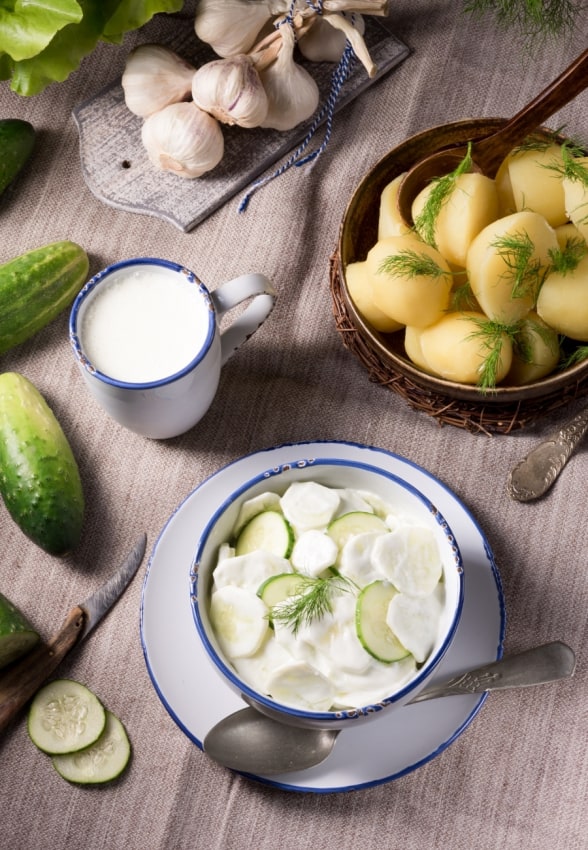Mizeria Recipe: Polish Cucumber Salad
Polish people tend to eat seasonal things. It’s always been a tradition to wait a whole year for something seasonal since the produce wasn’t imported (avocados, I’m looking at you!).
The beginning of the summer is time for fresh fruits like berries or apricots, Summer was perfect was sunflowers (in Poland we never eat sunflowers peeled off, you buy the whole head and dig it out yourself), then at the end of summer is time for chanterelle mushrooms.
Cucumber season falls sometime between spring and summer. This is when mizeria and Polish pickled cucumbers reign on Polish tables, along with other summer recipes like chlodnik or kompot.
Polish cucumber salad is one of the best salads or sides for traditional dinner. A salad of fresh cucumbers and sour cream with dill has been conquering our palates for decades. It’s simple and quick to do.


The True History of Mizeria & Why Most English-Speaking Sources Get It Wrong
Every single English speaking source, blog, or article tells a completely made-up story on how Mizeria came to Poland and became popular. They all claim that Queen Bona Sforza, the Italian wife of King Sigmund III brought it to Poland alone with other vegetables and made them all popular.
I’m not sure where did the gossip start (I think every new article is simply copying another one without any research), but Mizeria and cucumbers have absolutely NOTHING to do with Queen Bona Sforza.
The Queen indeed wanted to bring her Italian influence to the Polish court she introduced some Italian dishes and vegetables that weren’t well known in Poland yet. Cucumbers, however, weren’t on her list at all.
In Poland we even have a pack of vegetables called włoszczyzna (literal translation is “Italian things”) that’s attributed to the Queen. It includes carrots, root and leaf parsley, celery and leek and sometimes also savoy or white cabbage. It’s sold together to just put in your jar and cook a soup bouillon on it – like rosol.
However, even włoszczyzna is actually a myth. Queen’s experiment of bringing new flavors to the country did not go over very well. Poles hated everything she tried to serve them and she’s been ridiculed many times because of it.
The truth is that no one really knows exactly how the cucumber salad was introduced to Poland, but many researchers agree that it was the dish created by the poor.
The name of Mizeria is somehow confusing, as it means “misery”, as back in the Early Modern era only the poor were eating. It was somehow a symbol of poverty and misery. These days, however, everyone eats this Polish cucumber salad even at the fanciest restaurants.

Polish Cucumber Salad Recipe Pointers
- If your cucumbers are fresh and small, then there’s no need for you to peel them. You can prepare your mizeria with skins.
- There are two versions of mizeria: traditional and Warsaw Mizeria. Warsaw Mizeria uses vinegar in the recipe vs the traditional one does not.
- There’s no need to remove seeds if the cucumbers are in the season and fresh.
Mizeria: Polish Cucumber Salad Recipe

Mizeria - beloved Polish cucumber salad.
Ingredients
- 2 Cucumbers
- 4 spoons of cream (18%)
- Salt
- 1 spoon of dill
- 1 spoon of powder sugar
- 2 spoons of lemon juice
Instructions
- Peel the cucumbers, then slice them very thinly - you can use vegetable guillotine or simply cheese slicer.
- Spread the cucumbers and put some salt on them, then put them aside.
- After 10 minutes pat and press with a paper towel to get rid of extra water.
- In a small bowl mix sour cream and lemon juice (+ vinegar if desired), then add sugar and dill. Add cucumbers and mix it all together.
- Put in the fridge for an additional 10-15 min.
Nutrition Information:
Yield:
4Amount Per Serving: Calories: 150







